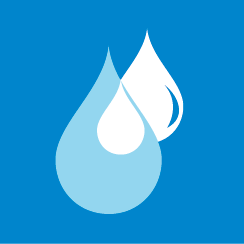
Water Resources

Clean and Renewable Energy

Indoor Environmental Quality

Water Resources
Stormwater Retention Tank– The southwest corner of the property features a 42,000-gallon stormwater detention tank to control run-off entering the sewer system.
Restrooms– Restrooms feature waterless urinals, dual-flush toilets, low-flow faucets, and sustainable paper and cleaning products. Harvested rainwater and grey water is used to flush all fixtures.
Water Tank– Rain and meltwater are collected from the roof, stored in an 8,000-gallon tank, and used to flush toilets, reducing both the consumption of drinkable water and the amount of water that is discharged to the sewer.
Green Roof– Plantings on the laboratory roof, made up of six different varieties of sedum, provide rainwater retention and a visible connection to nature, while also reducing the heat island effect.

Energy
Insulation– Solid façades include superior insulation to reduce heating and cooling loads. Interior insulation uses Demilec, a soy-based spray foam. Exterior insulation boards were created from sustainable natural fiber materials.
Radiant Ceilings– Most of the heating and cooling in rooms is provided via ceiling panels that carry warm or cool water to condition spaces via radiation. This method used less energy than typical HVAC systems because it does not require changing the air temperature.
Windows– The south façade features highly insulated glass with integrated electronically controlled blinds that provide solar heat and glare control, capable of operation at 15-degree increments. The ceramic white dots on the windows passively reduce glare and solar heat gain.
Roof– The building roof is designed to reflect most of the sunlight, minimizing solar heat gain and reducing the cooling load. The roof is also designed to allow future installation of photovoltaics, building-scale wind turbines, and roof top HVAC units.
Façade Testbed– The south façade of the laboratory wing includes an opening of the building envelope that can be used to test future building envelope and window systems.
Laboratory Exhaust– Air from laboratories is exhausted at low speed via a tall stack, which saves energy compared to conventional high-speed designs.
Energy Recovery Ventilator– This advanced energy recovery ventilator exchanges heat and moisture between outgoing and incoming air streams, significantly reducing the amount of energy required to condition incoming air.
Regenerative Elevator– The Otis elevator generates electricity on the way down, which can then be used for going back up, used elsewhere in the building, or fed back into the grid.
Underfloor Heating– Hot water is circulated through tubes installed in the lobby floor to provide efficient heating with a high level of comfort.
Boiler– The boiler, made by The Fulton Companies, touts 93% efficiency and uses the latent heat of vaporization to create more heat.
Heat Pumps– Carrier heat pumps provide optimal thermal comfort for the COE by exchanging heat with the geothermal wells or with the air outside. The heat pumps generate hot and cold water based on building needs .

Indoor Environmental Quality
Vapor Intrusion System– Ventilation below the foundation prevents underground vapors from entering the building, eliminating a potential source of contaminants in indoor air.
Urban Ecosystem Observatory– The 150-foot Urban Ecosystem Observatory tower is being used for a long-term, one-of-a-kind study that will assess Syracuse’s urban air quality, air flow, and how outside air affects air quality inside a building.
Demand-Controlled Ventilation- The amount of fresh air delivered to a room varies depending on carbon dioxide level. When people are present, the CO2 level increases and more air is supplied to the space. This saves energy when rooms are partially occupied.
Furniture– Furniture by Haworth and Herman Miller is made from recycled materials and FSC wood and wood products. Furniture is also 100% recyclable by the manufacturers upon return.
Lighting- High efficiency compact fluorescent and LED lighting, controlled by a daylight harvesting (auto dimming) system and auto shut-off occupancy sensors, are used throughout the building.
Carpet– Carpet tiles by InterfaceFLOR are made from recycled materials and installed with minimal adhesive. Zero waste was created by our order: extra carpet tiles were sent back to the manufacturer to be used for another order.
Kitchenette– Cabinets were created by RB Woodcraft out of a unique e2e Materials product that uses renewable grass fibers processed with a soy protein-based resin system.
SyracuseCoE Offices– The third floor houses SyracuseCoE staff, who work to catalyze collaborations among academic, industry, and government partners to create environmental and energy innovations for a sustainable future. The open office configuration allows for maximum daylighting, air circulation, and enhanced views. This suite can also be used for testing of new heating, ventilation, and air conditioning systems.
Willis H. Carrier Total Indoor Environmental Quality (TIEQ) Laboratory– A unique facility, funded by NYSTAR, Carrier, and Empire State Development, in which researchers study how multiple factors—including temperature, humidity, air quality, lighting, and sound—combine to affect human health and performance in built environments.
P. Ole Fanger Room– This conference room is dedicated to the memory of Professor P. Ole Fanger of Denmark for his contributions to the field of thermal comfort and ventilation, and for his service as University Professor at Syracuse University during 2006-07.


Building Sustainability Features
Building Shape and Form– The building is relatively narrow, reducing brownfield site disturbance and excavation, with extensive windows providing a high level of occupant comfort with ample natural light and opportunities for views and natural ventilation.
Underfloor Ventilation and Raised Flooring– Ventilation is provided close to occupants for improved thermal comfort using a raised floor system, allowing for even air distribution with lower fan speeds. The Tate raised floor system is situated 12 inches above the concrete deck and provides convenient wire routing.
Natural Ventilation Indicator Lights– Manual windows are provided to allow for natural ventilation throughout the building. Red and green lights alert occupants when it is best to open windows based on measurements of outdoor temperature, humidity, air quality, and wind speeds. While the windows are open, sensors notify the building management system to reduce the amount of mechanical ventilation to save energy.
Building Management System– The building automation system installed by Siemens ensures that heating, ventilation, air conditioning (HVAC), and other building systems perform in harmony. The system provides information needed to maximize energy efficiencies and optimize indoor air quality, such as advising occupants when outside conditions are favorable for natural ventilation, controlling the amount of artificial lighting, and managing the blind controls to reduce glare and heat gain.
Air Treatment Modules (ATMs)-These Carrier ATM units are European technologies being introduced in the US for the first time. They allow individuals to control their environment to meet personal preferences at desktops located at the Carrier TIEQ Lab. Energy use measurements for these units allow for optimal control of comfort while balancing energy consumption
Other Notable Features
Building Energy and Environmental Systems (BEES) Testbed– Complementing the first-of-a-kind BEES Lab at Syracuse University, this SyracuseCoE facility provides “plug and play” capabilities for prototypes of new heating, ventilation and air conditioning (HVAC) systems and domestic hot water heating technologies
Solar Array– Positioned along East Washington Street are providing power directly into the building’s electric vehicle charging system. With an installed capacity of 12kW, the panels are able to offset some of the buildings electrical load.
Landscape Design– Large sloping landforms provide a dynamic reflection of the building, as well as a means for safely encapsulating contaminated soil instead of shipping it to a distant landfill.
Brownfield Remediation– Environmental contamination associated with previous industrial site uses was remediated, restoring the site for sustained use by future generations.
Electrochromic Windows– Office suite 301 features energy-efficient windows with dynamic glass that optimizes daylight, outdoor views and comfort while preventing glare, fading and overheating.
Sustainable Construction Practices– The construction team, led by LeChase, diverted 98% of construction waste from going to a landfill.
SyracuseCoE Quick Facts
Cost: $46 million (funded from state and private sources)
Size: 55,000 square feet
Location: The three-acre site on the corner of Almond and Washington streets is a designated “brownfield,” the former site of the LC Smith typewriter factory and Midtown Plaza.
LEED Rating: Platinum
